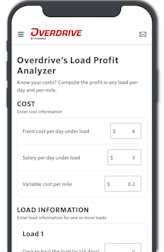Trucking news and briefs for Tuesday, April 22, 2025:
Tariffs expected to prolong freight recession
Market conditions for motor carriers in February improved to near neutral from a more negative January, according to FTR’s monthly Trucking Conditions Index (TCI) report.
FTR’s TCI improved to -0.21 in February from January’s -2.56 reading due to improved volume and utilization, along with smaller increases in fuel costs that mostly offset weaker freight rates.
The firm’s outlook is not as optimistic as it has been in recent months, however.
“With global tariffs and a full-fledged trade war against China, we have reduced our economic and freight forecasts due to expectations of higher inflation and interest rates and a weaker labor market, coupled with a payback from elevated imports in the first quarter to avoid tariffs,” said Avery Vise, FTR’s vice president of trucking. “With this change, we expect that near-term truck freight market conditions will be more challenging for carriers, postponing a sustained recovery until early next year.”
Similarly, ACT Research in its latest “Freight Forecast: Rate and Volume Outlook” report said it expects tariffs “to extend the for-hire freight recession,” as 20-25% of U.S. surface freight is involved in international trade, the organization noted.

“As Q2 begins, retail sales are still brisk as consumers snap up pre-tariff prices, but freight demand fundamentals face major self-inflicted tariff headwinds,” said Tim Denoyer, ACT Research’s Vice President and Senior Analyst. “The pre-tariff inventory stocking period will soon reverse, and consumption will fall as prices rise. We expect a few more months of brisk demand for pre-tariff goods, followed by a tariff adjustment period with lower goods demand. Freight is very much in the crosshairs of the trade war.”
Denoyer added that trucking “also faces considerable supply shocks related to new U.S. government policy. Both equipment and labor supply are affected, and this is likely to press truckload rates up after tariffs take their toll.”
Looking at more current market conditions in the volatile spot freight markets, FTR and the Truckstop load board reported that during the week ending April 18, broker-posted spot rates for dry vans fell to their lowest level since late-April 2024, while reefer spot rates were the highest in 10 weeks. Flatbed rates continued their climb, hitting their highest level since October 2022. During the week, dry van rates were down 2 cents, reefer rates were up 7.4 cents, and flatbed rates were up 5.6 cents.
 The increases in reefer and flatbed rates helped boost total broker-posted spot rates during the most recent week. Total rates jumped 3.6 cents for the 10th straight increase. Total rates last week were up 6.4% y/y -- the strongest prior-year comparison since April 2022 -- and were more than 1% above the five-year average for the week.Truckstop, FTR
The increases in reefer and flatbed rates helped boost total broker-posted spot rates during the most recent week. Total rates jumped 3.6 cents for the 10th straight increase. Total rates last week were up 6.4% y/y -- the strongest prior-year comparison since April 2022 -- and were more than 1% above the five-year average for the week.Truckstop, FTR
Flatbed rates throughout the first part of the year have led those gains, and as noted, that continued for platform haulers this past week.
Yet load-post activity overall fell last week by 11%, adding to the previous week's larger 15% fall. That followed 10 straight weeks of volume increases. Flatbed posts accounted for the biggest drop after its sustained run-up, suggesting that the bulk of its strength from February until the recent drop was likely due to pulling ahead imports in advance of tariffs, Truckstop/FTR noted.
[Related: Freight signals encouraging (for now): ATBS' annual owner-operator income update]
What's the flatbed-rates run-up been worth to owner-operators in the spot market?
For a quick comparison of just what flatbed rates' rise has been worth over the course of the year thus far, we reached back to Overdrive's Load Profit Analyzer to assist the calculation.
With fuel prices only having fallen slightly since the low point for national average flatbed rates in January ($2.23/mile) and their high point now, we used identical cost figures in the Analyzer to just compare the rates difference. (Costs were based on ATBS averages, as was the case in the last example scenario we charted in the story at this link.)
Bottom line? Flatbed freight demand improvement has been worth roughly a couple Benjamins' per day worked in the bank account.
[Related: What's an extra 1 mpg worth in profit at today's freight rates?]
Truck tonnage declined in March
The American Trucking Associations reported Tuesday that trucking activity in the United States slowed in March, giving back a little more than half of the gain from February. Specifically, truck freight tonnage decreased 1.5% after surging 2.8% in February, according to ATA’s advanced seasonally adjusted For-Hire Truck Tonnage Index.
 ATA's Truck Tonnage Index fell in March after a sizeable increase in February.ATA
ATA's Truck Tonnage Index fell in March after a sizeable increase in February.ATA
“Solid manufacturing output in March, led by robust auto production, likely helped truck freight tonnage not fall more after a very strong February,” said ATA Chief Economist Bob Costello. “Overall in the first quarter, tonnage increased marginally from both the fourth and first quarters of 2024. While the gains were not strong at half a percent and less, it was the first time that the quarterly average increased both sequentially and from a year earlier in two years. That tells me that the freight market did in fact turn around in the first three months of the year despite an uncertain outlook.”
In March, the ATA advanced seasonally adjusted For-Hire Truck Tonnage Index equaled 113.4, down from 115.1 in February. The index, which is based on 2015 as 100, was up 0.2% from the same month last year, the third straight year-over-year increase, which hasn’t happened since late 2022 and early 2023.
The not seasonally adjusted index, which calculates raw changes in tonnage hauled, equaled 114.6 in March, 9.5% above February’s reading of 104.7.
[Related: Freight markets, fraud, predatory towing, pay-to-park: Small-biz trucking challenges]
Volvo Group cutting workforce over tariff uncertainty
Volvo Group North America announced to workers last week it will be laying off associates at three locations over the next three months.
The layoffs will hit Volvo Trucks’ New River Valley plant in Dublin, Virginia; Volvo Group’s powertrain operations in Hagerstown, Maryland; and Mack Trucks’ Lehigh Valley plant in Macungie, Pennsylvania. The company estimated it will cut 50 to 100 people from the Hagerstown powertrain facility and 250 to 350 people apiece from the Volvo Trucks and Mack Trucks locations.
[Related: Mack unleashes a monster with 'badass' new on-highway tractor]
Volvo Group cited market uncertainty due to tariffs, potential regulatory overhaul and softening new vehicle demand for the downsizing.
In a response to a Virginia news station, Volvo Group Director of Public Relations Janie Coley stated, “We regret having to take this action, but we need to align production with reduced demand for our vehicles.”
Volvo Group’s action is just the latest act of downsizing in the commercial vehicle production sector over the last year. Kenworth announced layoffs at its Chillicothe, Ohio, facility last summer, and Daimler Truck announced global workforce reductions of its operations in February.
[Related: Good news, bad news: Owner-operator revenue down, but income finally rising]












